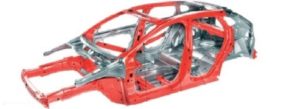February 23, 2016
 Proper annealing procedure for ZnFe coated boron steels in the direct press hardening process were developed in FIMECC BSA program. The achieved understanding of the material behavior in relation to the characteristics of the manufacturing process is vital for improving and optimizing the material properties of press hardening steels in future. Enabling the use of ZnFe coated boron steels in the direct press hardening process would bring efficiency for the production of high-strength safety components of car body, improve the passive safety of passenger cars and reduce the fuel consumption.
Proper annealing procedure for ZnFe coated boron steels in the direct press hardening process were developed in FIMECC BSA program. The achieved understanding of the material behavior in relation to the characteristics of the manufacturing process is vital for improving and optimizing the material properties of press hardening steels in future. Enabling the use of ZnFe coated boron steels in the direct press hardening process would bring efficiency for the production of high-strength safety components of car body, improve the passive safety of passenger cars and reduce the fuel consumption.
Direct press hardening process is a metal processing method increasingly utilised in the production of safety components of car body. Safety components improve the crash resistance of the car increasing the safety of car passengers. In addition to high strength, the automotive industry sets additional requirements for the components, such as outstanding corrosion protection, weldability and paintability. This creates demand for coated steel grades as coating provides corrosion protection in service.
The formation of the final material properties is complicated. The initial steel and coating properties together with process parameters define the final material properties, such as corrosion protection, weldability, paintability, strength and cost-effectiveness. In order to fully utilize the direct press hardening process in production of automotive components the material behavior need to be deeply understood.
In FIMECC BSA program the proper annealing procedure for ZnFe coated boron steels in the direct press hardening process were defined and understanding of the material behavior was fulfilled. The idea is that with the right process parameters (e.g. heat treatment, forming and quenching) the mechanical properties can be improved and the corrosion protection of the final products can be ensured. Through that, the full potential of the direct hardening process and steels with zinc-based coating can be deployed in automotive industry.
The achieved result is an important step in supplementing the understanding of the material behavior of ZnFe coated boron steels in the direct press hardening process and in developing the material properties in the future. The result provides guidelines to the future material development and helps solving the challenges faced by the automotive industry by enabling the production of car safety components with better properties and in a more efficient manner. The automotive industry is demanding new materials with improved properties, such as strength and corrosion protection. In addition the material currently used requires comparatively long process time and cannot provide cathodic corrosion protection. Thus, due to technical and commercial reasons automotive manufacturers have been seeking for alternative materials.
Based on earlier research steels with zinc-based coatings have shown a great potential. However, the material behaviour of ZnFe coated boron steels in direct press hardening process has not been fully understood. For example, zinc-coated steels are susceptible to cracking during the processing. The suitable process parameters for producing the proper coating structure with minimized cracking and appropriate corrosion properties was defined in FIMECC BSA program.
The utilisation of ZnFe coated steel and direct press hardening process would offer several advantages over currently used solutions. The solution enables the production of higher strength steels enhancing the passive safety of the car. In addition, higher strength enables the reduction in thickness of the components leading to lower weight. This results in energy savings, decreased fuel consumption and carbon dioxide emissions. Moreover, the corrosion protection, weldability and paintability are better than in currently used materials.
In addition to enhanced material properties the solution offers advantages in the production. Process times can be reduced and the dimensional accuracy of components after the direct press hardening process is excellent.
